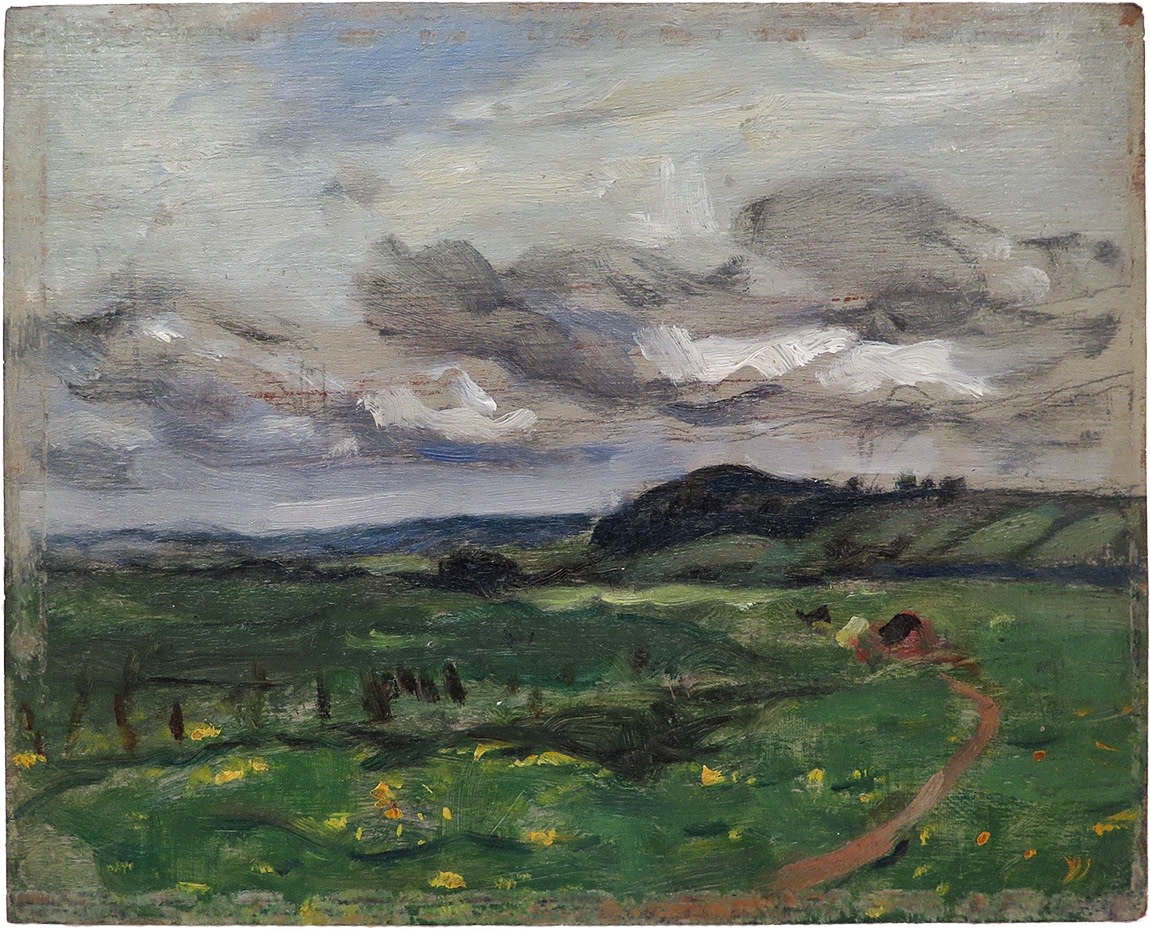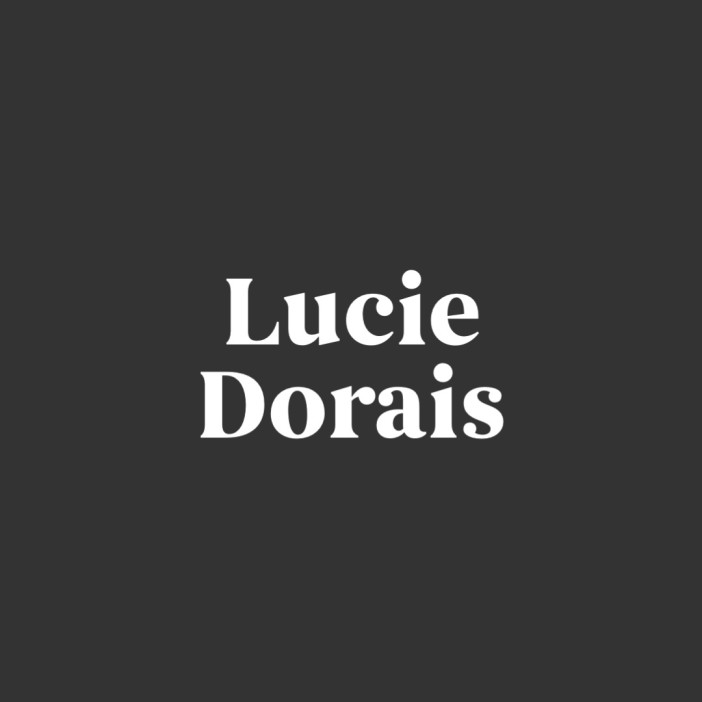A "calm and airy vision" by James Wilson Morrice
Paris, Venice, Brittany, then exotic places in North Africa or the West Indies: these were “painting places”, what we expect to see. Often a town, big or small, but never far from the water; so such a simple, pure landscape is rather rare, except for the early years of his career. In spite of its small dimensions, the view encompasses a wide panorama, made even wider by the importance given to the sky and the clouds. We are in a grassy meadow; the path (or the road?) loosely follows a stream (or a river?), towards a big hill (or a mountain?). There are some colour patches near the water in middle ground: animals drinking in the water, or small houses in a hamlet? The only elements that could give us a certain sense of the scale are the fence at left, and the yellow flowers at our feet…

James Wilson Morrice, Landscape, c. 1909
Oil on wood panel
Private Collection, Ottawa
The composition recalls an early painting, Landscape with River, but there the fence in the foreground, the trees in the middle and, more importantly, the small woman walking on the path give us the scale. The artist, still learning, described exactly what he saw, not with the precision of an Academic painter, but not with an Impressionist eye either. This Landscape shows the Crafnant river near Trefriw, North Wales, in the valley of the Conway. Can we locate our little panel the same way? And is it really important? Perhaps... We know so little about Morrice the man that any little bit of information adds a new pebble to our understanding; we would like to know which countryside was so attractive that he left the sea behind, and why he felt compelled to record this calm and airy vision. And if we could date the work more accurately, we could link it to one of the artist’s numerous trips.
It is not an early work: its technique places it roughly after 1906-07, because there is some fine pencil drawing under the paint, but before Morrice’s second trip to Morocco in 1912- 13, when there is much more pencil in his sketches. Here, the pencil marks, mostly visible in the sky, belong to a previous, unfinished drawing: we guess a structure with thin posts (or a house with a thin chimney?) on the left, a wooden jetty (or a row of windows with tiny square glasses?) on the bottom right, and a hilly horizon higher than the present one.
Comparing our Landscape sketch with others of that period, the quest rapidly narrows to the years 1909-1910. Since Morrice spent most of that time in Concarneau, Brittany, I first visited that region “virtually”, but I quickly discarded it. Ditto for Québec City and its environs, where he spent part of the summer of 1910. I eventually came upon a sketch very close in terms of composition and palette, The Promenade, Dieppe, study for a canvas of the same name (both now hang side by side in the Thomson Collection at the Art Gallery of Ontario).
The location of Promenade, Dieppe’s minimalist composition would be hard to identify, if Morrice had not given this title to the canvas in the Spring of 1911 (Paris, Société Nationale). There is no recorded trip to Dieppe the previous winter, or even in 1910, but on September 14, 1909, the Canadian artist wrote from there to a friend in Toronto. After asking the date of the next Canadian Art Club show, he continues, “I have so many shows to send to (...) I have just sent off my pictures to the Salon d’Automne, and have come to Dieppe to get a breath of air”; in his next letter, sent from Paris on November 6, he adds: “I was out in the country” (both: Art Gallery of Ontario, E.P. Taylor Library, Edmund Morris Fonds).
So we have a possible place, Dieppe, hardly new territory for the artist; he often painted there from the early 1890s, plus he often spent a fortnight while waiting for a crossing to England. He first painted the heart of the city around the Avant-port, with its small fishing boats and its big ferries; later, he turned his gaze towards the sea, its pebble beach and its long jetties, and obviously the seaboard Promenade. We also have a purpose, a well needed holiday after a painting marathon: the Salon d’Automne was devoted to recent paintings, and the catalogue of the 1909 edition lists nine entries for Morrice, a record.
At this point, we need to supplement the few documents we have with a little dose of speculation if we want to discover the quiet little landscape that so touched our artist; so let’s join him. In Dieppe, in September 1909, Morrice wanted to relax; he had brought the little sketchbox that nicely fit into his pocket, but he rarely took it out: observing people walking along the beach Boulevard has its limits. Perhaps he could venture out of town? Even away from the coast? He could certainly afford a hired car with chauffeur, as he would later do in London (Letter from Augustus John to Dorelia McNeill, (early) summer 1913, National Library of Wales).
Old guidebooks mention only one worthy excursion inland from Dieppe, to Arques-la- Bataille; there Henri IV won a decisive battle in 1589, below a medieval castle, whose ruins overlook the confluence of three small rivers (the Béthune, the Eaulnes and the Varenne) into the Arques river, which empties into the sea at Dieppe, six kilometers down. Two “Google Images” of Arques soon pointed me to a hill whose profile looked familiar, further down the Arques valley. I followed the map until I had a good view of that hill (unfortunately, it does not allow to walk away from roads). I had arrived at the small hamlet of Étables, near the Varenne river, about 15 kilometers from Dieppe. Its name, which translates as “Stables”, testifies to its humble status; there are no old postcards of it, not even of the bigger town it belongs to, Saint-Germain d’Étables (about 300 souls). Thanks to the confluence of the three rivers, now canalized into large basins, Saint-Germain has become a popular “fishing village” (mostly trout).
The hill’s silhouette is not exactly the same as the one Morrice painted, but its general shape is, and the flat landscape of the valley around it seems typical of the arrière-pays of the coast around Dieppe. And if the dark blue form in the painting foreground is a river (yes, the Varenne is that narrow!), then the indistinct forms in the middle ground are placid Norman cows drinking water, a popular Salon subject. Indeed, School of Barbizon member Charles-François Daubigny painted a similar subject in 1875, in the same Arques valley...
A note on Provenance: This sketch was owned by a descendent of landscape painter Frederick W. Hutchison, who "was a great admirer of Morrice (...) it is unknown whether the two artists ever met or whether Morrice exerted any direct influence upon the younger artist." [Stephanie A. Thomas: Frederick William Hutchison (1871-1953), M.A. Thesis, Concordia Univ., Montreal, 1982, p. 23, interviewing Kathleen Daly Pepper in Toronto February 1978]. It is unlikely: Morrice was still unknown during Hutchison’s stay in Paris, 1899 to 1901. Back in Montreal, the young artist immediately worked on commissions from affluent patrons, before moving to the United States in 1905. He had a long teaching career at the College of the City of New York, coming back most summers in his native Québec to paint, mostly in Charlevoix. He moved back to Canada definitely in 1939, settling at Hudson Heights, not far from Montreal. (Biographical info from Thomas’ thesis).
Robert Bruce Morrice (1867-1942), who wrote his name on the back of the panel (as he often did), was a younger brother of our painter. After some training in England, he joined “D. Morrice, Sons & Co” in Montreal (ab. 1896-1909), becoming a co-partner in 1905; in early 1907, thanks to his father’s involvement in Dominion Textile, he was named a partner of John Gordon & Sons, another Montreal merchant, and the new agents for Penmans Company, newly acquired by Dominion Textile: the mother company specialized in cotton, Penmans of course in woolen products. R.B. Morrice eventually became Vice-President, then President, of both Penmans and Gordon. He never left Redpath Street, even after his (late) marriage; the couple shared the family home with the eldest brother William James, who never married, and six or seven domestics; when it was demolished, he immediately purchased a unit in Redpath Row built on the spot. The stamp on the back of the sketch and the Scott label mean that it was selected by R.B. after his brother’s death in Tunis and the repatriation of his paintings from Paris by F.R. Heaton, the executors of his will.
Copyright © Lucie Dorais, 2018
Cite this article:
Dorais, Lucie. “‘A calm and airy vision’ by J.W. Morrice”. Klinkhoff.ca, Alan Klinkhoff Gallery, 25 June 2018., URL. Accessed [enter today’s date].





Add a comment